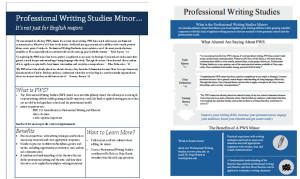Guest Blogger Miranda Romano ’16
 I have been focusing a great deal on design over the course of our CUPID studio client project, and I have been considering the ways audience and purpose effect design. Designing to match another person’s ideas can be difficult, but there is a lot to learn while experimenting with different ideas and perspectives.
I have been focusing a great deal on design over the course of our CUPID studio client project, and I have been considering the ways audience and purpose effect design. Designing to match another person’s ideas can be difficult, but there is a lot to learn while experimenting with different ideas and perspectives.
The project I worked on this semester involved advertising and creating documents for the Professional Writing Studies minor. Our purpose was “To increase awareness and appeal of the Professional Writing Studies minor for students across all academic disciplines.” The minor is not very well known and has a stigma of being only an English minor. We wanted to eliminate this and market directly to communication students as well as the rest of the student body. We needed to create and distribute new marketing materials to improve the advertising of the minor. I worked specifically on the redesign of the marketing documents. The following are some important tidbits I have learned over the course of this semester about designing for a client.
Go big. Don’t be afraid to take design risks and to change things up. If the client doesn’t approve, you can always go back and tweak things to create the documents that your client wants. During the creation of the first draft of the sell sheet redesign, I was worried about stepping on the client’s toes and completely changing the content of the document as well as the design. So I played it safe and went minimal with the design to fit all of the original text into the document. Then, when I showed it to the client, I was told that the document was too text heavy and not that visually appealing. After that, I scrapped the first draft and cut down the text and focused on making the document more visually appealing. The final product looked nothing like my original idea, but the client was pleased and that made me proud of my work.
Communication is key. Without talking through the design with the client, you will end up wearing yourself out with redesign after redesign falling flat. If you discuss your design with the client and understand exactly what they are looking for, any adjustments you make will be in line with what they are looking for. The best way to do this is to ask the clients direct questions about your work. Do not simply ask if they like it. Ask them direct questions in terms of the layout, the text and any image you may have included. Ask them if it aligns with what they were imagining and ask them what they think should change. Having answers to these questions will give you a goal when you sit down to do redesigns.
The first draft is probably not going to be the right draft. Don’t be upset, there is always room for revision when it comes to design, especially when a client is involved. Sometimes, it may take several different versions of the design before the client is satisfied with what you have produced. When I was redesigning the sell sheets for our client project, my first draft ended up with huge amounts of white space and little aesthetic elements. I didn’t think it was great, but it included all the text so I thought it would work. After talking to the client, I started over completely and created a document that looks more like an infographic in terms of its design. The client was much happier with the potential of the new document. If I had fought the client to keep my original document, things could have gone very poorly. Don’t be afraid of redesign and be willing to try out new elements and formats.
A link to the site I used to make the infographic design.
The following is my original design (left) and what I created after talking to my client and redesigning (right).


 Follow
Follow